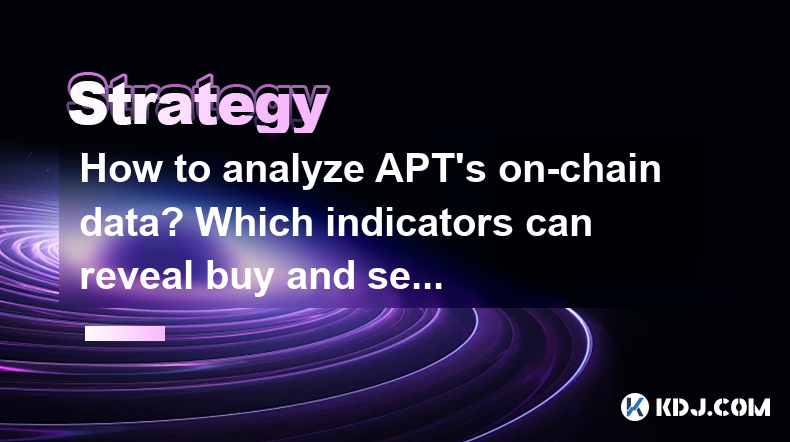-
 bitcoin
bitcoin $107208.295278 USD
-1.54% -
 ethereum
ethereum $3874.629914 USD
-1.38% -
 tether
tether $1.000440 USD
0.03% -
 bnb
bnb $1089.465513 USD
-5.53% -
 xrp
xrp $2.327672 USD
-1.65% -
 solana
solana $184.766505 USD
-0.73% -
 usd-coin
usd-coin $1.000076 USD
0.02% -
 tron
tron $0.310632 USD
-1.99% -
 dogecoin
dogecoin $0.187615 USD
-1.60% -
 cardano
cardano $0.633389 USD
-2.75% -
 ethena-usde
ethena-usde $0.999553 USD
0.03% -
 hyperliquid
hyperliquid $35.608231 USD
-4.13% -
 chainlink
chainlink $16.876114 USD
-3.98% -
 stellar
stellar $0.312239 USD
-0.91% -
 bitcoin-cash
bitcoin-cash $473.262969 USD
-7.09%
How to analyze APT's on-chain data? Which indicators can reveal buy and sell signals?
Analyzing APT's on-chain data involves key indicators like transaction volume, active addresses, and large transactions to identify buy and sell signals effectively.
Apr 30, 2025 at 02:42 pm

Analyzing on-chain data for Aptos (APT) involves examining various metrics and indicators that can provide insights into market sentiment and potential buy and sell signals. This process requires a systematic approach to gather and interpret data from blockchain explorers and other analytical tools. In this article, we will delve into the key indicators that can help identify buy and sell signals for APT and how to analyze them effectively.
Understanding On-Chain Data
On-chain data refers to the information recorded on a blockchain, which can be analyzed to gain insights into the behavior of network participants. For APT, this includes transaction volumes, active addresses, token holdings, and other metrics that can indicate the health and activity of the network. By analyzing this data, traders and investors can make more informed decisions about when to buy or sell APT.
Key Indicators for Analyzing APT
To effectively analyze APT's on-chain data, it is essential to focus on several key indicators. These indicators can provide a comprehensive view of the token's performance and potential future movements.
Transaction Volume
Transaction volume is a fundamental indicator that measures the total number of APT tokens being traded over a specific period. High transaction volumes can indicate strong interest in the token, which may suggest a potential price increase. Conversely, low transaction volumes might signal a lack of interest, potentially leading to price stagnation or decline.
To analyze transaction volume:
- Use a blockchain explorer or on-chain analytics platform to access APT's transaction data.
- Compare current transaction volumes with historical data to identify trends.
- Look for spikes in volume, which may indicate significant buying or selling activity.
Active Addresses
Active addresses represent the number of unique addresses participating in transactions on the Aptos network. An increase in active addresses can indicate growing adoption and interest in APT, which may be a positive signal for potential price appreciation. Conversely, a decrease in active addresses might suggest waning interest.
To analyze active addresses:
- Use an on-chain analytics tool to track the number of active addresses over time.
- Compare the current number of active addresses with historical data to identify trends.
- Pay attention to significant changes in the number of active addresses, as these can indicate shifts in market sentiment.
Large Transactions
Large transactions, often referred to as whale transactions, involve the movement of significant amounts of APT tokens. These transactions can influence the market, as large holders (whales) have the power to impact prices through their buying and selling activities.
To analyze large transactions:
- Use a blockchain explorer to identify transactions involving large amounts of APT.
- Track the frequency and size of these transactions over time.
- Consider the potential impact of these transactions on the market, as they may signal upcoming price movements.
Token Holdings and Distribution
Token holdings and distribution provide insights into how APT tokens are distributed among different addresses. A concentration of tokens in a few large addresses may indicate potential market manipulation or significant influence by a small group of holders. Conversely, a more even distribution can suggest a healthier and more decentralized network.
To analyze token holdings and distribution:
- Use an on-chain analytics platform to view the distribution of APT tokens across addresses.
- Identify the percentage of tokens held by the top addresses and compare it with historical data.
- Monitor changes in token distribution, as shifts can indicate changes in market dynamics.
Network Growth and Development Activity
Network growth and development activity are indicators of the overall health and potential of the Aptos network. An increase in network growth, such as the number of new addresses and transactions, can suggest growing interest and adoption. Similarly, high levels of development activity, such as frequent updates and improvements to the protocol, can indicate a committed team and a promising future for APT.
To analyze network growth and development activity:
- Use on-chain analytics tools to track metrics such as the number of new addresses and transactions.
- Monitor development activity through platforms like GitHub, where you can view the frequency of commits and updates to the Aptos protocol.
- Consider the impact of these metrics on the long-term potential of APT.
Identifying Buy and Sell Signals
Based on the key indicators discussed above, traders and investors can identify potential buy and sell signals for APT. These signals can help inform trading decisions and improve the chances of successful outcomes.
Buy Signals
Buy signals indicate potential opportunities to purchase APT at favorable prices. Some common buy signals include:
- Increasing Transaction Volume: A significant increase in transaction volume, especially when accompanied by a price increase, can indicate strong buying interest and potential for further price appreciation.
- Rising Active Addresses: An increase in the number of active addresses suggests growing adoption and interest in APT, which may lead to a price increase.
- Positive Network Growth: Strong network growth, such as an increase in new addresses and transactions, can indicate a healthy and expanding ecosystem, potentially leading to higher prices.
- High Development Activity: Frequent updates and improvements to the Aptos protocol can signal a committed team and a promising future, which may attract more investors and drive up the price.
Sell Signals
Sell signals indicate potential opportunities to sell APT at favorable prices. Some common sell signals include:
- Decreasing Transaction Volume: A significant decrease in transaction volume, especially when accompanied by a price decrease, can indicate waning interest and potential for further price declines.
- Declining Active Addresses: A decrease in the number of active addresses suggests diminishing adoption and interest in APT, which may lead to a price decrease.
- Negative Network Growth: Weak network growth, such as a decrease in new addresses and transactions, can indicate a struggling ecosystem, potentially leading to lower prices.
- Low Development Activity: Infrequent updates and a lack of improvements to the Aptos protocol can signal a less committed team and a less promising future, which may deter investors and drive down the price.
Tools for Analyzing APT's On-Chain Data
To effectively analyze APT's on-chain data, it is important to use reliable tools and platforms that provide comprehensive and accurate information. Some popular tools for on-chain analysis include:
- Blockchain Explorers: Platforms like Aptos Explorer provide detailed transaction data and other on-chain metrics for APT.
- On-Chain Analytics Platforms: Tools like Nansen and Glassnode offer advanced analytics and insights into various cryptocurrencies, including APT.
- Data Aggregators: Websites like CoinMetrics and CryptoQuant aggregate on-chain data from multiple sources, providing a comprehensive view of the market.
To use these tools effectively:
- Select the appropriate tool based on your specific needs and the type of data you want to analyze.
- Familiarize yourself with the tool's interface and learn how to access and interpret the data it provides.
- Regularly monitor the data to stay updated on the latest trends and developments in the APT ecosystem.
Frequently Asked Questions
Q: Can on-chain data predict the exact future price of APT?A: On-chain data can provide valuable insights into market sentiment and potential price movements, but it cannot predict the exact future price of APT with certainty. It should be used as one of many tools in a comprehensive trading strategy.
Q: How often should I analyze APT's on-chain data?A: The frequency of analysis depends on your trading strategy and goals. For short-term traders, daily or even hourly analysis may be necessary, while long-term investors might find weekly or monthly analysis sufficient.
Q: Are there any risks associated with relying solely on on-chain data for trading decisions?A: Yes, relying solely on on-chain data can be risky, as it does not account for other important factors such as market news, macroeconomic trends, and regulatory developments. It is important to use on-chain data in conjunction with other analysis methods to make well-informed trading decisions.
Q: Can on-chain data be manipulated to mislead investors?A: While it is possible for on-chain data to be manipulated, reputable blockchain explorers and analytics platforms take measures to ensure the accuracy and integrity of their data. It is important to use trusted sources and cross-reference data from multiple platforms to minimize the risk of manipulation.
Disclaimer:info@kdj.com
The information provided is not trading advice. kdj.com does not assume any responsibility for any investments made based on the information provided in this article. Cryptocurrencies are highly volatile and it is highly recommended that you invest with caution after thorough research!
If you believe that the content used on this website infringes your copyright, please contact us immediately (info@kdj.com) and we will delete it promptly.
- Crypto News, October 2025: Missed Stories You Need to Know
- 2025-10-18 08:45:14
- PAX Gold (PAXG): Riding the Crypto Gold Rush in the Digital Age
- 2025-10-18 08:25:14
- Dogecoin, PEPE, and Remittix: Navigating the Crypto Landscape in Late 2025
- 2025-10-18 09:10:15
- Quant Eyes Rebound: Can $75 Support Level Hold?
- 2025-10-18 08:45:14
- Bitcoin's Wild Ride: Crypto Crash Wipes Out $600 Billion!
- 2025-10-18 08:25:14
- Crypto Market Check: Renewed Buying for ETH, ADA, SUI Amidst Market Jitters
- 2025-10-18 08:50:12
Related knowledge

Practical parameter settings for a Bitcoin multi-timeframe moving average system
Sep 18,2025 at 10:54pm
Optimizing Timeframe Combinations for Bitcoin Trading1. Selecting appropriate timeframes is crucial when building a multi-timeframe moving average sys...

How can I filter out false breakouts in Dogecoin high-frequency trading?
Sep 22,2025 at 01:00am
Understanding False Breakouts in Dogecoin Trading1. A false breakout occurs when Dogecoin's price appears to move beyond a defined support or resistan...

Techniques for identifying tops and bottoms in the Bitcoin on-chain NVT model
Sep 20,2025 at 07:54pm
Understanding the NVT Model in Bitcoin Analysis1. The Network Value to Transactions (NVT) ratio is often described as the 'P/E ratio' of the cryptocur...

What does the surge in open interest in Bitcoincoin futures mean?
Sep 20,2025 at 11:18pm
Understanding the Surge in Dogecoin Futures Open Interest1. A surge in open interest within Dogecoin futures indicates a growing number of active cont...

How can I use the Ethereum USDT premium to gauge market sentiment?
Sep 18,2025 at 11:55pm
Understanding the Ethereum USDT Premium1. The Ethereum USDT premium refers to the price difference between USDT (Tether) traded on Ethereum-based plat...

What should I do if Ethereum staking yields decline?
Sep 20,2025 at 06:18am
Understanding the Causes Behind Declining Ethereum Staking Yields1. The Ethereum network transitioned to a proof-of-stake consensus mechanism with the...

Practical parameter settings for a Bitcoin multi-timeframe moving average system
Sep 18,2025 at 10:54pm
Optimizing Timeframe Combinations for Bitcoin Trading1. Selecting appropriate timeframes is crucial when building a multi-timeframe moving average sys...

How can I filter out false breakouts in Dogecoin high-frequency trading?
Sep 22,2025 at 01:00am
Understanding False Breakouts in Dogecoin Trading1. A false breakout occurs when Dogecoin's price appears to move beyond a defined support or resistan...

Techniques for identifying tops and bottoms in the Bitcoin on-chain NVT model
Sep 20,2025 at 07:54pm
Understanding the NVT Model in Bitcoin Analysis1. The Network Value to Transactions (NVT) ratio is often described as the 'P/E ratio' of the cryptocur...

What does the surge in open interest in Bitcoincoin futures mean?
Sep 20,2025 at 11:18pm
Understanding the Surge in Dogecoin Futures Open Interest1. A surge in open interest within Dogecoin futures indicates a growing number of active cont...

How can I use the Ethereum USDT premium to gauge market sentiment?
Sep 18,2025 at 11:55pm
Understanding the Ethereum USDT Premium1. The Ethereum USDT premium refers to the price difference between USDT (Tether) traded on Ethereum-based plat...

What should I do if Ethereum staking yields decline?
Sep 20,2025 at 06:18am
Understanding the Causes Behind Declining Ethereum Staking Yields1. The Ethereum network transitioned to a proof-of-stake consensus mechanism with the...
See all articles























![[4K 60fps] 5upreme by RoyalP (1 coin) [4K 60fps] 5upreme by RoyalP (1 coin)](/uploads/2025/10/18/cryptocurrencies-news/videos/k-fps-upreme-royalp-coin/68f2e6c9ef491_image_500_375.webp)


















































